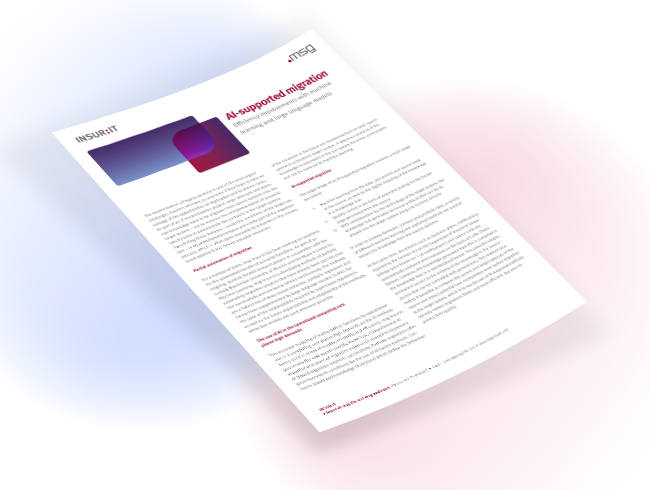Accuracy is the first challenge. A statistical prediction quality of 99 per cent, for example, is good enough for applications such as image recognition and internet searches. However, it is unacceptable in the insurance sector where strict regulations apply.
Automating policy migration with machine learning

Executive summary
One of the most promising technological innovations is artificial intelligence and machine learning, with countless start-ups attempting to develop the next big thing in every aspect of society. Machine learning is already in use in many parts of the insurance industry, including fraud detection. However, there are still challenges to be overcome in the core actuarial business.

The second challenge is explainability. Machine learning can produce white-box or black-box models. With black-box models, a person is not normally able to understand or explain how the model produces results. A lack of explainability is a serious problem in terms of compliance with regulations in the insurance sector, such as when it comes to calculating guaranteed premiums, benefits and surrender values.
At the same time, artificial intelligence promises to deliver tremendous value and help perform expensive, time-intensive tasks more efficiently in an economically challenging environment.

The modernisation of legacy systems in life insurance business is the most pressing priority in order to meet growing customer expectations, comply with regulatory requirements and develop new business models. This will pave the way to seize the opportunities of digitisation and lower costs in an economically challenging landscape.
‘Migration’ refers to the transfer of millions of insurance contracts from one or more source systems to a target system, including the re-implementation of actuarial functions designed to administrate the contracts in the target system. A migration project ties up extensive human resources in an insurance company. As automated migration processes cost the insurance company less time and money, these resources are free to invest in the development of innovative products and business models to attract new customers.

To understand how migration can be automated, we must first take a closer look at the conventional process. When insurance contracts are migrated to a new system, the datasets have to be transferred. The actuarial tools that administrate the contracts over time must also be consistent with the underlying business plans and original agreements with the customer. These functions can be understood as mathematical equations which define a relationship between input variables and an output variable, such as an insurance premium, provisions, benefits or surrender values.
Transferring these functions is the complex and costly part of the migration, because they are highly individualised. In the conventional approach, actuaries had to find the functions in the source system, analyse them and attempt to compare them against the functions in the new or target system. If they did not match, a function from the new system would have to be adapted or a new function would have to be generated. Given the millions of contracts being migrated, this is a lengthy process and gobbles up valuable resources.

For a number of years, msg insur:it has been working to develop and provide a viable solution that transfers actuarial functions automatically.
One of the most powerful methods is to use deep neural networks, which are generally considered the gold standard among machine learning methods. The strength of deep neural networks is their ability to approximate complex functions, work with large datasets and learn dynamically. Deep neural networks are black-box models in which the relationship between input and output is not explained.
In contrast, symbolic regression – a white-box model – searches through all possible formulae relating to given operators and basic functions and determines a formula that best fits the input and output data. As such, it is explicitly explainable. Although it is not efficient with highly complex equations, it is often suitable for actuarial functions.
Neural trees, which are related to neural networks, essentially use the structure of logic or decision trees, with which most of us are familiar. Just like symbolic regression, they are not suitable for highly complex equations, yet are often powerful enough to fulfil actuarial functions. They are deterministic and therefore explainable.
A hybrid combination of deep neural networks, symbolic regression and neural trees addresses the problem of explainability and accuracy, both situationally and adequately. For the insurance industry, the use of these methods in core actuarial functions really is a first. As part of an ongoing, publicly subsidised research project known as TRAIL.X (TRustworthy Artificial Intelligence in Life Insurance), msg insur:it has developed an innovative solution to partially automate migrations which is already being used in real-life situations.
In light of the challenging environment, the pressure to modernise IT systems continues to grow. However, the high costs and long project durations deter many insurers from taking this step. With partially automated migrations, msg insur:it provides the technology to tackle necessary consolidation projects at a reasonable cost.






